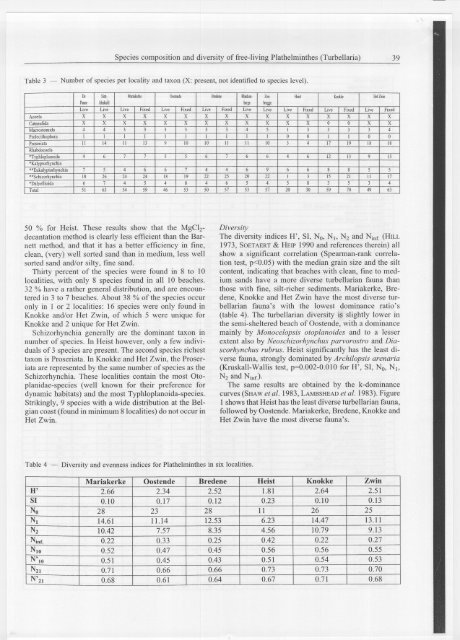Species composition and diversity of free-living Plathelminthes ...
Species composition and diversity of free-living Plathelminthes ...
Species composition and diversity of free-living Plathelminthes ...
Create successful ePaper yourself
Turn your PDF publications into a flip-book with our unique Google optimized e-Paper software.
- -<br />
<strong>Species</strong> <strong>composition</strong> <strong>and</strong> <strong>diversity</strong> <strong>of</strong> <strong>free</strong>-<strong>living</strong> <strong>Plathelminthes</strong> (Turbellaria) 39<br />
Table 3 - Number <strong>of</strong> species per locality <strong>and</strong> taxon (X: present, not identified to species level).<br />
De Sinl. Marial:e!te Oostende Btedene Blanken- Ztt- Heist Knokke HdZwin<br />
Panne ldesbald bag< brugge<br />
Live Live Live Fixed Live Fixed Live Fixed Live Live Live Fixed Live Fixed Live Fixed<br />
Acoela X X X X X X X X X X X X X X X X<br />
Catenulida X X X X X X X X X X X X 0 0 X X<br />
Macrostomida 4 4 3 3 3 3 3 3 4 5 I 3 3 3 3 4<br />
Prolecithophora 1 I I 1 1 1 1 I I I 0 0 I 1 0 0<br />
Proseriata 11 14 11 IJ 9 10 10 11 11 10 3 4 17 19 18 18<br />
Rhabdocoela<br />
*Typhloplanoida 4 6 7 7 5 5 6 7 6 6 4 6 12 IJ 9 15<br />
*Kalyptorhynchia<br />
uEukalyptorhynchia 7 5 4 6 6 7 4 4 6 9 6 6 8 8 5 5<br />
**Schizorhynchia 18 26 24 24 18 19 22 25 20 22 1 3 15 21 11 17<br />
*Dalyellioida 6 7 4 5 4 8 4 6 5 4 5 8 3 5 3 4<br />
Total 51 63 54 59 46 53 50 57 53 57 20 30 59 70 49 63<br />
50 % for Heist. These results show that the MgChdecantation<br />
method is clearly less efficient than the Barnett<br />
method, <strong>and</strong> that it has a better efficiency in fine,<br />
clean, (very) weil sorted s<strong>and</strong> than in medium, less weil<br />
sorted s<strong>and</strong> <strong>and</strong>lor silty, fine s<strong>and</strong>.<br />
Thirty percent <strong>of</strong> the species were found in 8 to 10<br />
localities, with only 8 species found in all 10 beaches.<br />
32 % have a rather general distribution, <strong>and</strong> are encountered<br />
in 3 to 7 beaches. About 38 % <strong>of</strong> the species occur<br />
only in 1 or 2 localities: 16 species were only found in<br />
Knokke <strong>and</strong>lor Het Zwin, <strong>of</strong> which 5 were unique for<br />
Knokke <strong>and</strong> 2 unique for Het Zwin.<br />
Schizorhynchia generally are the dominant taxon in<br />
number <strong>of</strong> species. In Heist however, only a few individuals<br />
<strong>of</strong> 3 species are present. The second species richest<br />
taxon is Proseriata. In Knokke <strong>and</strong> Het Zwin, the Proseriata<br />
are represented by the same number <strong>of</strong> species as the<br />
Schizorhynchia. These localities contain the most Otoplanidae-species<br />
(weU known for their preference for<br />
dynamic habitats) <strong>and</strong> the most Typhloplanoida-species.<br />
Strikingly, 9 species with a wide distribution at the Belgian<br />
coast (found in minimum 8localities) do not occur in<br />
Het Zwin.<br />
Table 4 - Diversity<strong>and</strong> evennessindices for <strong>Plathelminthes</strong>in six localities.<br />
Diversity<br />
The <strong>diversity</strong> indices H', SI, No, Nb N2 <strong>and</strong> Ninf. (HlLL<br />
1973, SOETAERT& HElP 1990 <strong>and</strong> references therein) aU<br />
show a significant correlation (Spearman-rank correlation<br />
test, p

















